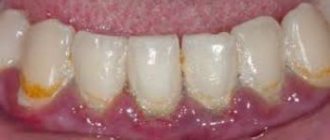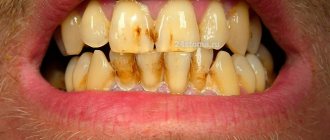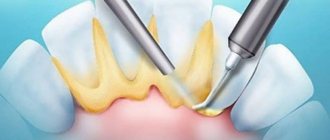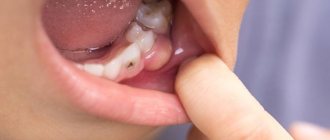Causes of darkening of teeth near the gums
The condition of teeth and enamel is affected by many everyday factors, as well as various dental diseases.
Household factors include:
- abuse of coffee, tea, red wine;
- smoking;
- frequent consumption of natural juices (for example, grape or tomato);
- taking certain medications that contain ferrous gluconate.
Coloring drinks provoke the appearance of enamel pigmentation, which is easily eliminated with professional teeth cleaning.
Pathological processes that provoke the accumulation of dark plaque on the enamel in the gum area:
- cervical caries;
- tartar;
- fluorosis (a disease characterized by a high content of fluoride in the human body).
Cervical caries is the most common cause of dark spots on teeth. Pathology is one of the most dangerous types of the carious process, since it occurs in a hidden form, and the destruction of enamel occurs very quickly.
The disease develops in stages:
- A small pigment spot appears in the area of the tooth neck near the gum;
- Then the darkened area of enamel becomes rough;
- The tooth begins to react to external stimuli (sour, sweet, hot, cold), painful sensations appear;
- The stain on the enamel changes color from light brown to black.
The deep form of cervical caries is accompanied by severe destruction and most often turns into pulpitis.
Reasons for changing the shade of enamel
The causes of darkening of tooth tissue can be both internal and external.
External reasons
External factors contributing to the development of pathology include:
- failure to comply with hygiene rules and refusal to brush your teeth daily (food debris forms plaque, which destroys the crystal lattice of the enamel and causes a change in its color);
- eating high sugar-containing foods (the decomposition of sucrose entails the development of an oxidative reaction, which has a negative effect on the structure of tooth enamel);
- caries, accompanied by the appearance of dark carious spots on the surface of the teeth;
- smoking (tars that enter the oral cavity during smoking settle on the surface layer of tooth enamel, destroy it and contribute to a change in its color);
- abuse of black tea and strong coffee.
Internal causes of darkening of teeth are:
- defects in the formation and development of dental tissues;
- dental injury;
- drug-induced damage or pathologies associated with a lack of nutrients in the body.
The group of defects in the development of dental tissue includes a whole series of diseases of tooth enamel and dentin. Many of them are incurable, and the resulting changes in the shape, color and size of teeth are considered irreversible.
When teeth are injured, which often occurs unnoticed by the victim, pulp rupture may occur. The development of pathology is accompanied by the decomposition of dead tissue and staining of the tooth black.
The most common drug-induced damage to dental tissues, leading to changes in their color, is fluorosis. This disease occurs due to excessive concentrations of fluoride in water used for cooking. With a mild form of fluorosis, small white specks form on the enamel. With a complicated course of the disease, the surface of the teeth becomes covered with large black spots.
This group of causes of darkening of dental tissues also includes a lack of vitamins and other useful microelements in the patient’s body.
In this case, along with a change in the color of the enamel, the following development is observed:
- stomatitis,
- periodontal disease (bleeding gums),
- and in some cases - scurvy.
The most important factor influencing the color of tooth enamel is heredity. It is almost impossible to prevent hereditary blackening of teeth, but strict adherence to hygiene rules and a responsible approach to diet can slow down the progression of the pathology.
Why can baby teeth turn black?
Baby teeth are much more susceptible to caries than molars, since they do not have such a dense structure. Enamel can change color due to the development of various pathological processes that can be provoked in a child:
- fragility of tooth enamel;
- calcium deficiency;
- improper oral care;
- chips and cracks in the enamel;
- vitamin deficiency;
- endemic fluorosis;
- chronic gastrointestinal diseases;
- genetics.
Sometimes the cause of darkening of the teeth of very young patients is artificial feeding of the baby at night. Consuming formula or milk at night reduces saliva production. The acid that accumulates on the teeth during feeding is not washed away by saliva and the process of destruction of tooth enamel begins.
The tooth under the crown is rotting: what to do?
A dental crown is a dental element that helps restore the integrity of a tooth and its function. Over time, due to a combination of certain factors, decay processes may begin, which are accompanied by bad breath, pain and swelling of adjacent tissues, as well as darkening of the tooth. In such cases, you should immediately seek help from a doctor.
Why does a tooth deteriorate under a denture?
The main reason that causes tooth decay under the crown is its loose fit to the gum, when a cavity forms between the implanted element and the gum. Food particles get there, which is accompanied by rotting processes. This occurs when the crown is installed incorrectly or the materials are depressurized.
The photo shows tooth decay under the crown.
When the implant is not properly cared for, inflammation can develop. This condition is fraught with the occurrence of secondary caries, which subsequently destroys the supporting tooth.
Attention: before implantation, it is necessary to undergo preliminary treatment, that is, implants are installed only on healthy teeth!
Another reason for rotting can be the use of poor quality materials. Problems often arise during the manufacture of the prosthesis, or the dentist performs poor-quality pulp removal.
In patients with chronic pathologies of the digestive tract and gallbladder, rotting is observed due to changes in the acidity of saliva. With pathology of bone tissue, namely a violation of the absorption and assimilation of calcium ions, tooth decay also begins.
Problems with the dental crown can be caused by bad habits, especially smoking, and poor diet.
Clinical symptoms
An unpleasant odor appears first. It cannot be eliminated either by thorough cleaning or enhanced oral hygiene using antibacterial rinses.
As mentioned above, food debris gets clogged into the cavity between the crown and the tooth. This promotes the proliferation of bacterial flora, and subsequently leads to the appearance of an unpleasant odor.
Patients also often complain of a strange taste in the mouth, pus discharge, and pain. Visually, the tooth near the gum will turn black, and the implanted element itself will become mobile, which indicates a violation of fixation. Also, during the examination, redness and swelling of the gums near the damaged tooth will be noticeable, and if the situation is serious, then signs of swelling to the affected person.
What to do if a tooth rots
If you detect at least one of the above signs, you should immediately contact your dentist, because if you do not receive qualified help in a timely manner, serious consequences may develop, such as:
- Damage to other teeth.
- Inflammation of the oral mucosa.
- Sepsis (when pathogenic microorganisms enter the systemic bloodstream).
- Infectious damage to organs (bacteria spread throughout the body through the bloodstream, settle in various tissues and organs, causing their damage).
Attention: under no circumstances should you self-medicate, as this will only worsen the condition of the tooth.
For treatment, it is necessary to determine the causes of the inflammatory process, how far and deep it has spread, and most importantly, what condition the root canals are in. Only a dentist can fully accomplish this. He will conduct a diagnosis and offer treatment options.
What if food gets under the crown?
It is rare to encounter a situation where, after installing a dental crown, the patient is not bothered by anything. Over time, pain and discomfort go away. However, if they persist, and in addition there is an unpleasant odor or pain when chewing, this is a good reason to consult a doctor. If food gets stuck between the implant and adjacent teeth, the crown will need to be replaced because it was not installed correctly.
Crown loss
The implantation element may fall out if it is installed incorrectly. The problem lies in the fact that the prosthesis is fixed to unhardened cement.
The photo shows a crown falling out
There is a risk of accidental swallowing of the crown, so you should immediately consult a doctor. The dentist will recommend re-fixation on a stronger base.
Taste of blood in the mouth
The taste of blood in the mouth may indicate poor oral hygiene. In the place where the gum meets the enamel there is a circular ligament of the tooth. Food debris often gets clogged there, which can lead to bleeding. If this happens, you should improve your oral hygiene and be sure to use a irrigator for cleaning.
Putrid smell
While eating, pieces of food get caught under the crown. There, a favorable environment is formed for the growth of bacteria, which causes the process of rotting food and bad breath. Suppuration is accompanied by pain and, in some cases, discharge.
Many patients try to cope with the problem on their own, using various mouth rinses or even traditional medicine. However, the effect is very short-lived. In addition, the processes of inflammation and rotting under the crown are only getting worse.
In order to avoid the appearance of bad breath, it is necessary to properly care for the oral cavity and the installed implant.
Discharge
Discharge from under the crown may appear when pressing on the structure. This happens when gum inflammation develops there. Pus may be released when you press or open the pus sac, which will temporarily relieve the soreness. However, the problem will not be solved. If purulent discharge appears, you should urgently consult a doctor, as this process can lead to an abscess - acute inflammation in the root area with copious discharge of pus.
Tooth color changes
The reasons for the color change may be different:
- medications (tetracycline);
- injury;
- pulpitis;
- fluorosis (increased fluoride intake from water and food).
Changes in the color of teeth and gums directly depend on the materials from which the crown is made. If metal ceramics were used, then in the area near the gums it is possible to see the edge of white ceramics covering the metal frame. Sometimes it is a little translucent, and it seems that the tooth has turned blue. To achieve a more aesthetic effect, it is recommended to use a non-metal crown, for example, based on zirconium dioxide. The base of such crowns is white itself, so it will not stand out from the others.
Darkening may occur after root canal treatment - this is absolutely normal and will go away with time.
The color of the tooth may change if the expiration date of the dental element has passed.
Important: crowns should be replaced every 5-7 years, even if their shelf life is 10 years. Because there is a gradual change in gum tissue. They atrophy, tooth tissue is exposed, and it becomes more susceptible to external factors of aggression.
Has your tooth turned black?
Blackening of the tooth is dangerous. This indicates tissue destruction and requires immediate treatment. In such cases, the crown is removed, the dentist assesses the condition of the tooth, and then prescribes appropriate treatment.
Treatment of a tooth under a crown
The dentist will select the correct treatment after visiting the clinic. It depends on how badly the tooth is damaged. Based on this, they distinguish:
- Replacement of the prosthesis - if the stump was not affected. It will be enough to clean out any remaining food from under the crown and replace it. This is possible if you seek help in a timely manner.
- Additional installation of a core inlay is a system with so-called “legs” that fix the inlay on the tooth canals.
The photo shows stump inlays
Next, a crown is attached to it. This method of treatment is recommended if the roots of the tooth are preserved.
— Removal and implantation. If the entire tooth rots, the dentist removes it, performs hygienic cleaning of the oral cavity, and prescribes treatment for periodontitis. Only after this will the patient be referred for re-implantation.
Attention: when installing a dental crown for the first time, you should pay attention to what guarantees the dental clinic provides and what assistance it can provide in case of problems with the installed implant.
Correct care of a dental crown
Careful care is important and necessary for any type of implant, however, each of them has its own characteristics.
| Implantable element | Features of care | Additional funds |
| Metal-ceramic crowns | It is carried out in the same way as caring for regular teeth. You can use any brush. The movement should go in the direction from the gums to the edge of the crown. | To remove plaque between teeth, it is recommended to use special brushes and dental floss. |
| Bridges | Particular attention is paid to the flushing channels between the gums and crowns. | Also used are brushes, thread and an irrigator, which allows you to quickly and efficiently clean the cavities from food debris. |
Bridges Particular attention is paid to the flushing channels between the gums and crowns. Also used are brushes, thread and an irrigator, which allows you to quickly and efficiently clean the cavities from food debris. Table 1. – Correct care of implanted elements.
There are some dietary recommendations when installing a dental implant:
- Reduce the consumption of drinks high in caffeine and coloring pigments (tea, coffee, wine, beets and others).
- Do not eat very hot or very cold food as this may cause the materials to crack or become unfastened.
- You should not clean seeds or nuts with teeth that have a crown installed.
- Solid food must first be cut into smaller pieces (this reduces the load on teeth with a crown).
- You should not overuse chewing gum, toffees and other viscous foods, because they can stick to the implant and contribute to its loss.
It is also recommended to undergo special professional ultrasonic cleaning at the dentist several times a year.
Attention: the patient must notify the doctor about the installed implants.
Oral hygiene
In order to avoid problems after implant installation, it is necessary to carry out thorough daily oral care.
Firstly, you need to brush your teeth 2 times a day using special brushes. Secondly, after each meal it is necessary to rinse your mouth with special means and then with running water. Thirdly, special additional products have been developed that are recommended for oral care:
- Interproximal brush for cleaning hard-to-reach areas and spaces between the crown and teeth.
- Bundle brush for cleaning the space between the crown and the tooth.
- Dental floss for cleaning spaces between teeth.
- Irrigator (a device that operates under pressure: water pressure removes food debris from the most inaccessible areas).
When to see a doctor
If you experience any discomfort, you should make an appointment with your dentist. Even if there are no inflammatory processes or disorders, consulting a professional is still better than self-medication. The doctor will clearly explain the cause and reassure the patient, and if a pathology is detected, he will immediately prescribe treatment.
Attention: you should not hesitate to go to the doctor, the pain, unpleasant odor and discharge from under the crown will not go away on their own. These conditions require quality treatment!
Professional help
Treatment begins with diagnosis and determining the causes of the pathology. After eliminating the causes that provoke the darkening of the enamel, appropriate treatment is prescribed.
The method of treating cervical caries depends on the stage at which the pathology was noticed:
- At the dark spot stage, remineralizing therapy is used: the tooth is cleaned of soft plaque and hard dental deposits, and the affected area is covered with an application containing fluoride.
- In case of superficial and medium caries, the affected area is prepared, after which the tooth is filled.
- At the stage of deep caries, as a rule, the pulp is removed and the canals are cleaned. After this, the tooth is filled.
Causes of complications after fixed prosthetics
Errors in diagnosis and planning of orthopedic treatment
Errors in diagnosing and planning orthopedic treatment
Perhaps the most important and most difficult stage of orthopedic treatment is planning and choice of design. An incompletely studied medical history, insufficient X-ray examinations and incorrect interpretation of images, an inattentive approach to the patient’s complaints. All this today is a gross mistake by the doctor.
Mistakes when preparing the oral cavity for prosthetics
Before orthopedic treatment, it is necessary to carry out sanitation of the oral cavity: professional oral hygiene, removal of severely damaged teeth that cannot be properly restored with fillings or inlays, therapeutic treatment of teeth necessary according to indications, and soft tissue and bone grafting is also possible. Errors in preparation can be detected after prosthetics, so a very careful approach of all doctors is necessary.
Errors in the clinical stages of prosthetics
Orthopedic treatment usually consists of several stages. Making a mistake at any of the medical stages can lead to adverse consequences. The most common medical errors in permanent prosthetics include incorrect preparation of teeth , inaccurately taken impressions, incorrect bite determination, incorrect fitting of frames, non-compliance with the rules when installing a prosthesis, as well as non-compliance with the stages of prosthetics.
Errors in technical stages of prosthetics
Half the success of proper orthopedic treatment depends on the dental technician. Failure to comply with certain rules for the manufacture of dentures leads to further complications. Most often, these are errors in the inaccurate production of plaster models, poor casting of frames, and incorrect modeling of the cutting or chewing surface of the teeth by a dental technician.
Effective methods for getting rid of plaque on tooth enamel
At home, it is difficult to get rid of old black plaque. The use of an electric toothbrush with pastes containing fluoride is rather a preventive measure, a prophylactic procedure that reduces the possibility of plaque and its degeneration into tartar. It is possible to effectively and without consequences remove unpleasant plaque from tooth enamel only in a specialized clinic. Dental Med dentistry offers several effective methods for removing black plaque and, if necessary, subsequent dental treatment:
- To remove soft plaque, the Air Flow sandblasting technique is used; its operating principle is simple: “washing off” using a mixture of soda and water. The procedure somewhat weakens the top coating of enamel, so after cleansing, the teeth are treated with a special protective compound. The method will not cope with hard, old plaque.
- A painless cleaning procedure that does not damage tooth enamel is gentle laser plaque removal. After it, the gums are not damaged and do not bleed, which sometimes happens after sandblasting.
- If you need to remove plaque on teeth with weak, loose enamel, an ultrasonic device will help. With the help of which you can carefully and painlessly remove not only hardened black plaque, but also tartar.
There is also a folk method of “whitening” darkened teeth. When a mixture of soda, activated carbon and hydrogen peroxide is intensively rubbed into tooth enamel using a cotton swab. The method can cause more harm than good, since it still won’t cope with complex and hardened plaque. But it can definitely thin and destroy tooth enamel. Let us separately consider the darkening of wisdom teeth. Treatment of wisdom teeth is, in principle, complicated by their location on the jaw.
Since hard-to-reach teeth have no functional or aesthetic load, it is recommended to remove them in case of caries or partial destruction. If you are somehow concerned about the blackening of your wisdom teeth, you can solve this problem individually by discussing possible options with your dentist.
What to do if a crown falls out -
The simplest option is when the crown falls out not because of carious destruction of the tooth tissue underneath, but because of poor cement fixation of the crown on the tooth. The main reasons for the loss in this case: mistakes by the dentist when fixing the crown with permanent cement, low clinical height of the crown (in this case, the crown will always fall out with regularity). In this case, it is enough to immediately contact your dentist to have a new crown fixed on your tooth.
1) What to do if a crown with a pin falls out -
Often, when preparing a tooth for prosthetics, a pin or stump inlay is fixed in the root canal. If your crown and pin fall out, this is again due to poor quality work by dentists. The fact is that severely damaged tooth crowns (before prosthetics with crowns) are restored by good dentists not with the help of pins, but with the help of stump inlays.
How a tooth is restored using a pin and filling -
Therefore, if the crown of your tooth was almost completely destroyed and it was restored with the help of filling material and a pin, the loss of the crown will be a pattern, because such a design is simply not able to withstand normal chewing pressure. By the way, no less often in such situations, the pins lead to a root fracture, after which the tooth is removed altogether.
If such a crown falls out, then the filling material with a pin sticking out of it remains inside the crown. Of course, it is possible to simply cement all this over again in the root canal (and we are sure that you will find dentists who will be ready to do this), but this is absolutely forbidden. Here you need to restore the tooth again - preferably with a stump tab, and then make a new crown. Otherwise, you will simply lose this tooth.
2) If the crown falls out along with the stump tab -
If a badly damaged tooth was restored not with a pin, but with a stump tab, the crown may also sometimes fall out.
This is usually also due to dentist mistakes. The fact is that after fixing the stump tab in the root canal, many dentists, saving time, begin to file it with burs within 15 minutes and take an impression. The fact is that after fixing the stump tab, a whole day must pass before you can begin to adjust it with a drill. If the adjustment is made 10-20 minutes after fixation, which some dentists like to do to save time, then vibration when processing the inlay with a drill will lead to partial destruction of the cement that has not yet fully hardened. This leads to the fact that after a week, a month or six months, the crown falls out along with the stump tab.
How a tooth is restored using a stump inlay -
What to do - unlike the situation when the tooth was restored with a filling and a pin - such a structure can still be re-fixed in the root canal (without the need to replace the crown), but only if you immediately contact the dentist.
The crown lies on the gum: what to do
Very often there are cases when inflammation of the gums begins around the artificial crown - as a result of which the gums swell, grow, and chronic inflammation is constantly maintained in this place. Most often, this is due to the fact that the crown injures the edge of the gum with its overhanging edges (which should not normally exist).
In some cases, the problem can be solved by surgical adjustment of the gingival margin, i.e. when part of the gum near the crown is removed. But according to the rules, the overhanging edge of the crown, which injures the gingival margin, is a warranty case, and you have the right to demand a replacement of the crown (if the warranty period has not yet expired, which is usually 1 year). We hope that our article was useful to you!
Sources:
1. Personal experience as a dentist, 2. “Orthopedic dentistry. Textbook" (Trezubov V.N.), 3. "Orthopedic treatment with fixed prostheses" (Rozenshtil S.F.).










